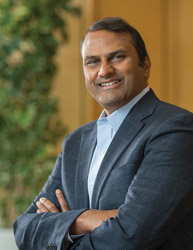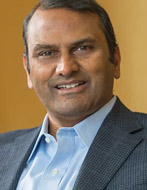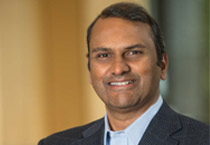Sri Ramachandran is chief technology officer of Numerex. He joined the company at the start of 2016 and is responsible for driving the company’s technology strategy with a focus on product development and engineering execution. He most recently served as CTO of Utilidata, an IoT and data analytics company driving energy efficiency in the electric power grid. Prior to that, he was CTO of Telcordia/Ericsson Interconnection Solutions, where he launched and established a new mobile messaging business. Here he tells IoT Now how he sees the IoT market developing and how, while everyone seems to have an IoT platform offering, a comprehensive IoT platform remains a valuable differentiator.
IoT Now: Given the recent DDoS (Distributed Denial of Service) attacks from internet-connected devices, what is your take on securing IoT devices? What are the other security implications, for example, malicious data manipulation?
Sri Ramachandran: The recent DDoS attack on 21 October 2016 that crippled critical internet sites such as Netflix, Paypal and Twitter, especially in the eastern half of the US, was found to have been launched by millions of internet connected devices. More specifically, a malware called the Mirai botnet was deployed to infect vulnerable internet connected cameras and digital video recorders that then coordinated this attack against the DNS infrastructure of one specific DNS provider, Dyn. The devices were considered open because the default administrator credentials were not changed after deployment. This clearly exposed the vulnerabilities of IoT devices, the failures in deployment best practices, and how their scale of deployments, and their always on nature can be exploited to make malicious attacks on broad internet infrastructure as well as targeted sites.
This is a wakeup call to device manufacturers – as well as enterprises – that special measures must be taken to ensure IoT devices cannot be exploited. At Numerex, security of devices starts with design and system architecture. Our philosophy is that security must be dealt with not only in technology, but also in process. Technology-wise, each device has its own internal firewall to prevent malicious inputs. We also ensure that all configuration and software updates delivered to devices go through a strict validation process that ensures confidentiality and integrity. Our delivery and deployment processes are tightly coordinated with the customer and their internal IT controls.

Sri Ramachandran, is chief technology officer of Numerex
Ultimately, IoT devices are only as good as the data they send out. If the data is manipulated either through deliberate erroneous inputs to the IoT device sensors, or while the data is in transit, it can lead to bad results. Imagine a bedside monitor of a critical patient’s vitals sending information to the doctor’s office. The consequences may be dire if the data is manipulated. Another example is tracking emergency supplies during a natural disaster recovery situation – having the right data at the right time is imperative to dealing with the circumstances. There are many other examples in industrial applications and large-scale systems such as the electric power grid, where the integrity of the data is critical. The consequences of bad data can range from minor inefficiencies to the enterprise to the worst case of catastrophic outcomes.
IoT Now: Besides connected car and connected home, what are the other areas in which IoT is making big inroads?
SR: Today, when one mentions IoT, the most common applications that come to mind are related to connected home and connected car. Both areas are seeing a lot of activity and the innovation seems boundless. The connected home started from three different sub segments that have now merged. The first one is home monitoring – essentially checking on pets, children and others who are entering or leaving the home. There are many solutions that comprise this segment, including video monitors, motion detectors and sound monitors.
The second is climate control and energy use monitoring. Controlling energy usage of a home contributes directly to the family’s monthly savings, making this an important area that has seen a lot of innovation. Companies such as Nest and a few major security companies have made great strides in this area. Control aspects have moved on from just climate control to include water heaters, lighting, water pumps, and sprinklers.
The third is home security. With improvements in technology, the once stand-alone industry of home security has now been inducted into the connected home space. Now homeowners have cloud-based apps that are accessible on a smartphone for home monitoring and control. Alarm panels can operate on a wireless network, notifying a dedicated call centre in the case of intrusion events. The home security market is very strong, and is incorporating the home monitoring segment into it, allowing service providers to deliver robust products offerings. Numerex has a strong brand and solution offering in this part of the connected home market.
The connected car sector is, again, a very large market. The automobile, for an individual or family, is their second most expensive asset after a home, and hence has a lot of economic value ascribed to it. The ecosystem of service providers that play a part in the lifecycle of an automobile is also extensive – insurance providers, service centres, infotainment providers and others. By connecting a car, it allows the entire ecosystem of service providers to play a role and enhance the experience for the car owner.
As a result, we have seen many sub-segments emerge in the connected car space – usagebased insurance (UBI), fleet tracking, maintenance tracking, car digital video recorders and other entertainment systems, with each segment growing very rapidly. With devices that can connect aftermarket cars, the market is no longer dependent on newer models only which have the OEM-enabled connectedness. Driver behaviour, energy usage and other pertinent data can also be gleaned from the connected car. Numerex has been present in the fleet tracking space for many years and has plans to continue upgrading and improving that offering into 2017.
Industrial IoT (IIoT) is not talked about much, but it is a larger market and has a diverse set of applications that rely on a range of devices and capabilities. Asset tracking in the supply chain using our iManage solution, and bulk liquids tank monitoring under our iTank managed service are two very robust areas where Numerex offers complete solutions. Tanks storing bulk liquids, such as petroleum products, chemicals, gases and even water are in general in need of remote, electronic monitoring. The business processes around measuring, draining, replenishing and distribution of liquids in these tanks have been built around highly manual and inefficient practices. Automating the business processes clearly brings a significant uplift in efficiency and return on investment in IoT.
IoT Now: What have been Numerex’s major product and technology accomplishments recently?
SR: Numerex has made major strides in its product and technology roadmap in 2016. We have launched several connected home products under the Uplink brand, and one product focused exclusively on the fire and security market. In the offender monitoring segment, we released a major upgrade of our application, that customers are eagerly migrating to.
At the same time, we launched a Lone Worker Safety (mPERS) product that is gaining traction. In the industrial IoT applications, such as asset tracking and tank monitoring, we have launched several new devices, one of which is certified to be Intrinsically Safe and hence can be used with flammable liquids. Among the new devices are those capable of using both cellular and satellite networks, which makes them applicable in versatile environments. We are also launching devices with rechargeable batteries – with these we can extend the life of the device to more than seven years. These devices can be charged by a small solar panel, making them attractive for deployment in remote environments.
We have also been advancing the software platform capabilities to improve scale and support migration of our customers from 2G networks to 3G and beyond.
IoT Now: Many IoT companies, including Numerex, provide an IoT platform. What are the key differentiators of your IoT platform? How do you see it enabling a growing IoT market?
SR: The term IoT Platform is very common today. Most companies claim they have one, and there is no standard definition of what the platform is. The way Numerex defines a platform is that it:
- Is a cloud-based software system using network-as-aservice to connect any number of IoT devices over different transport networks – such as cellular, satellite, LPWA and WiFi.
- Employs rich device and connection management capabilities via gateway services to allow customers to change configurations of their devices, update and upgrade the firmware. It also has very sophisticated high throughput message translation capabilities so that many different device types can be easily connected to the platform.
- Has adaptive security, so it can provide security at message, transport, device levels as well as enable different trust models between applications and the devices.
- Uses very advanced application enablement through application programme interfaces (APIs) that our customers and partners use for rapid integration.
- Is capable of very sophisticated billing, operations and management capabilities. The platform can support billing across any network type and any mode, such as flat rate, usage, tiered and others.
- Is supported 24×7 by our network operations centre (NOC) and technical professionals.
One of the many differentiators of our nxFAST platform is that it has operational maturity – we have more than two million IoT device connections live on the platform, supporting in excess of 1,000 different use cases. The platform supports many device types and many network types and a sophisticated rules engine so that we can enable what is called intelligence at the edge for IoT networks. These are significant differentiators that we don’t see deployed in the industry, but that our customers can take advantage of.
Supporting numerous device and network types is essential to the growing IoT market. Numerex’s platform provides just that. Based on the diversity of use cases we already support, there are going to be many more as business processes increasingly get automated.
IoT Now: The IoT market is growing very rapidly. What are your key initiatives to keep ahead of the market?
Sri Ramachandran: The challenge of IoT is the volume and diversity of use cases. Since IoT in the enterprise is primarily used to drive business process automation, we see that the number of use cases are very plentiful. Even in just one market, bulk fluid tank monitoring, we see many diverse use cases. The solutions that are deployed are different for tanks that move which require GPS based trackers, tanks that are stationary, tanks that are indoors and external tanks. The form of the solution that is deployed in each of those cases is very different and requires different devices, different data reporting characteristics, different applications, and different ways to control and manage them.
We want to make it very easy for our customers to do business with us. To this end, our business model is to provide a complete solution that our customers can deploy as a fully managed service from Numerex. This makes the rapid deployment and turn up of service paramount. Our modular device capabilities and the world-class software platform enable customers to quickly tackle their business problems. We have several initiatives going on to enable our customers to streamline their businesses. They want to integrate all the data generated from their deployment into their enterprise resource planning (ERP) or other business workflow solution. While batch processing is common, we are working on a rich API framework that will make this integration more streamlined and seamless.
The second technology initiative is around data mining and analytics. As our customers scale their deployments of our solution, they are generating significant amounts of device, process and business data. While the data is used to optimise day-to-day business operations, the data has not been used to address enterprise wide business decisions, especially in combination with other data. For example, in our tank monitoring scenario, the data from the tank monitors are used to make day-day tank fill route optimisations – such as how much fluid to carry, how much fluid to order, the most optimal route to take and others. However, when combined with bulk pricing data, weather/climate data, demographic and other macro information, our data analytics software can offer insights for the business as to optimise purchasing, inventory and route distribution decisions.

A third technology initiative is to refresh all our products to support LTE and its IoT variants. This enables us to easily track carriers’ LTE deployment roadmaps – for Cat1, CatM1, and CatM2.
We have taken a platform approach to our software and hardware. The software platform deployed in the Numerex cloud provides the key capabilities to enable support for diverse use cases – such as a sophisticated rules engine, high throughput message translation and transaction processing, advanced application enablement and a rich data model for supporting different device types. The hardware platform takes a modular approach to key IoT capabilities – such as network type, sensor inputs, power input and battery. These make it the most flexible technology approach to deal with the growing IoT market.
What is the future for IoT? How do you see it evolving? Are there other new markets that IoT will spawn?
SR: IoT is going to become a broad term that is going to signify many things. Today the focus is on things – gadgets and devices that we use to monitor and control. Most common applications of IoT today use the paradigm of monitor and control – this can be in connected lighting, industrial settings and many, many more. Gradually, we will see that the monitoring and the control will evolve independently.
Monitoring is essentially time series data being generated by these myriad devices – and the focus will move up from the device itself to the data that it is generating and all the models that can be applied to data. Data, especially time-series data, can be massaged, manipulated, aggregated and analysed to generate meaningful results – such as pattern recognition, trend generation and predictive projections. Data analysis technologies will gain even further prominence as more devices come online.
Similarly, when we look at control, we see steady evolution towards hierarchical and multi-tiered control. Industrial automation already has seen these advances in process control. Using IoT, we can extend these concepts to industrial business process automation.
In that sense, IoT is similar to the PC revolution. As the costs of computing, network and storage continue to go down, the focus shifts up to data analysis and what can be done with the data and how it helps run the business. Just as PCs are tools to run the business, so will IoT.










